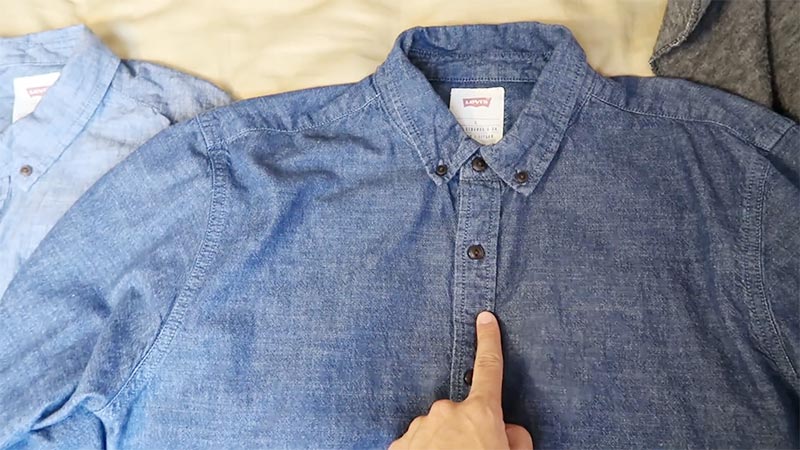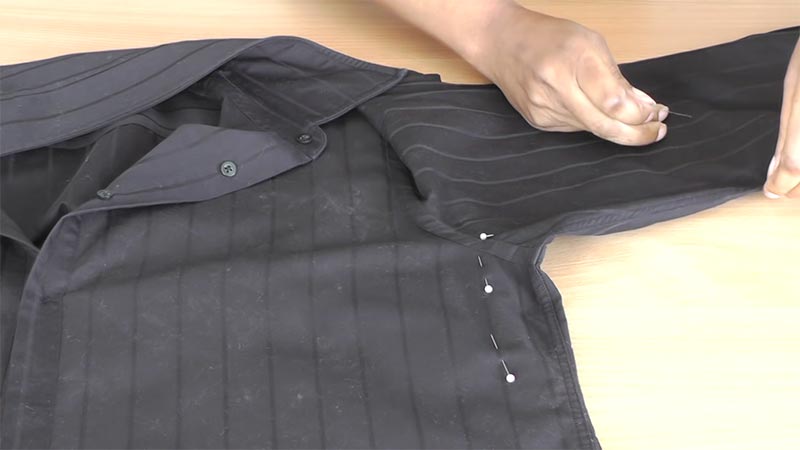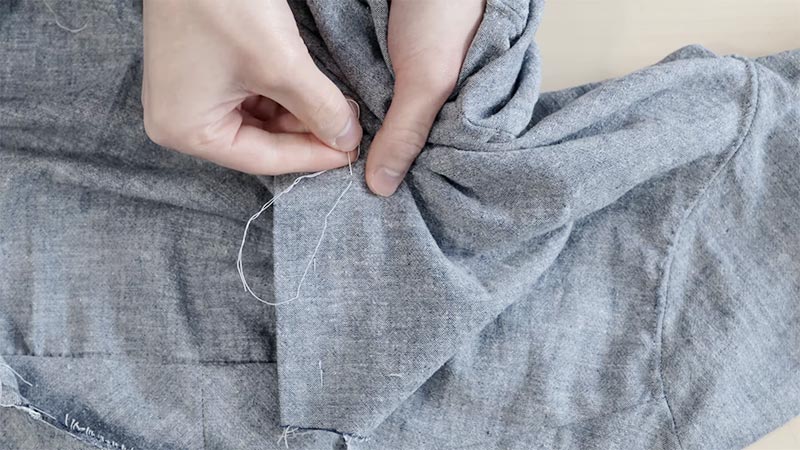With its breezy charm and versatile appeal, Chambray is a beloved fabric for crafting stylish garments and home textiles. However, sometimes, you might need to tailor its size or texture to perfection.
Whether you’ve bought a chambray garment that’s a tad too loose or you want to prepare fabric for a sewing project, the process of shrinking chambray can be both practical and rewarding.
This guide will explore the steps to shrink Chambray fabric easily and effectively.
With the right techniques and a bit of patience, you can achieve the ideal fit or texture, preserving the essence of this beloved fabric while customizing it to your preferences.

What Is Chambray Fabric?
Chambray fabric is a lightweight, plain-woven textile known for its versatility and casual elegance. It is crafted using a unique weaving technique that blends colored yarns, typically blue and white, to create a subtle, denim-like appearance.
Chambray is primarily composed of cotton, though it can sometimes incorporate other natural fibers.
Its distinguishing feature is how it combines the durability of denim with the softness and breathability of cotton, making it ideal for a wide range of clothing items like shirts, dresses, and blouses.
Its comfortable feel and timeless aesthetic have made chambray a popular choice for casual and semi-formal attire and various sewing and crafting projects.
How to Shrink Chambray Easily?
Shrinking chambray fabric can be a useful technique, especially if you’ve bought a slightly too big garment or are working on a sewing project and want to pre-shrink the fabric.
Chambray is a lightweight, plain-woven fabric made from a blend of cotton or a combination of cotton and other fibers. It’s known for its softness, breathability, and comfortable feel.
Here are steps you can follow to shrink chambray fabric easily:
Check the Fabric Content
Before attempting to shrink chambray, checking the fabric content label is crucial. While chambray is typically predominantly cotton, some blends may incorporate other fibers.
The higher the cotton content, the more effectively it can shrink. Understanding the composition of the fabric will help you gauge how much shrinkage you can expect.
Pre-Wash the Fabric
To initiate the shrinking process, wash the chambray fabric in hot water. Opt for the highest water temperature recommended for the fabric.
The heat is essential in encouraging the fibers to contract. While a small amount of detergent can be added, it’s advisable to avoid using bleach or any harsh chemicals that might affect the fabric’s integrity.
Dry on High Heat
After washing, transfer the chambray to the dryer and select a high-heat setting. Again, the application of heat is critical for achieving significant shrinkage.
When possible, choose a setting that allows for an extended drying time. This will facilitate the process and result in a more pronounced reduction in size.
Monitor the Fabric
During the drying process, keep a vigilant eye on the chambray fabric. Check on it periodically to assess whether it has achieved your desired level of shrinkage.
Depending on the fabric’s composition and the capabilities of your dryer, this may take several cycles. Patience and attentiveness are key to obtaining the desired results.
Use the Steam Setting
When the level of shrinkage achieved through the washer and dryer is not satisfactory, consider employing a steam iron. Hang the fabric and pass the iron over it using the steam setting.
The combination of heat and moisture from the steam can contribute to further shrinking, particularly in areas where additional reduction is desired.
Repeat if Necessary
Don’t hesitate to repeat the process if the fabric hasn’t shrunk enough after the initial attempt.
However, exercise caution, as excessive shrinking might alter the fabric’s texture or appearance. Gradual adjustments are often more effective and less likely to compromise the fabric’s quality.
Test a Scrap Piece
For those uncertain about how the chambray will react to the shrinking process, conducting a small-scale test is prudent.
This involves subjecting a scrap piece of fabric to the same treatment to gauge the amount of shrinkage it undergoes. This preliminary test will provide valuable insights before working on the entire piece.
Consider Professional Help
When working with a valuable or delicate chambray garment, or if you’re unsure about the fabric’s reaction to shrinking, seeking assistance from a professional dry cleaner is a viable option.
These experts possess the experience and specialized equipment needed to handle delicate fabrics, ensuring the process is carried out precisely and carefully.
Effective Alternative Methods to Shrink Chambray Fabric

While the traditional method of using hot water and a high-heat dryer is effective for shrinking chambray fabric, alternative methods can be employed, especially for those who prefer to avoid excessive heat or want to be more precise in the shrinking process.
Here are some alternative methods to shrink chambray fabric:
Steam Ironing
Steam ironing is a controlled approach to shrinking chambray fabric. Hang the fabric and set your iron to a low to medium heat setting.
Activate the steam function and pass the iron over the fabric, maintaining a bit of distance to prevent direct contact. Combining heat and moisture from the steam will encourage the fabric to contract gradually.
Place a pressing cloth between the iron and chambray surface to safeguard the fabric.
Boiling Water Soak
For a more direct method, consider a boiling water soak. Fill a sizable pot with water and bring it to a rolling boil. Immerse the chambray fabric in the hot water for a few minutes.
Afterward, carefully remove the fabric and gently wring out any excess water. While the fabric is still warm and pliable, carefully stretch and manipulate it to encourage shrinkage.
Steamer
Using a garment steamer offers a gentle and controlled way to shrink chambray. Hang the fabric and apply steam directly using the steamer. Move the steamer nozzle evenly across the surface.
The heat and moisture from the steam will coax the fabric to contract gradually. This method is particularly useful for delicate or intricately designed chambray items.
Tumble Drying with Towels
Try tumble drying with damp towels to create a controlled, humid environment. Place the chambray fabric in the dryer alongside a few damp towels.
The towels will release moisture, creating a humid atmosphere within the dryer.
This environment encourages the fabric to contract gradually. Opt for a medium heat setting and check the fabric periodically to avoid over-shrinking.
Spray Bottle and Dryer
A spray bottle and dryer combination provides a targeted approach to shrinking chambray. Mist the fabric lightly with water from a spray bottle until it’s slightly damp.
Then, place the fabric in the dryer in a high-heat setting. The added moisture, combined with the heat, will facilitate the shrinking process.
Washing with Vinegar
Introducing white vinegar to the wash cycle is another effective method. Add a cup of white vinegar to the wash along with the chambray fabric.
The acetic acid in the vinegar softens the fibers, making them more receptive to shrinking. Follow this with a wash in hot water and a high-heat dryer cycle.
Fabric Softener
Including fabric softener in the wash cycle can help relax the fibers of the chambray fabric. This, in turn, enhances the fabric’s ability to shrink. After the wash cycle, proceed with a high-heat drying cycle to further encourage shrinkage.
Sewing Darts or Pleats
Consider sewing darts or pleats in the chambray fabric for precise and localized shrinking. By creating small folds in specific areas, you can achieve targeted shrinkage without altering the overall appearance of the garment.
Tips for Avoiding Over-Shrinking

Avoiding over-shrinking is crucial when working with fabrics, especially those like chambray, which can be sensitive to excessive heat and agitation.
Here are some tips to help you prevent over-shrinking:
Use Cold Water for Pre-Washing
Before shrinking the chambray, consider using cold water for the initial wash. This can help remove any initial sizing or dirt without subjecting the fabric to high temperatures.
Gradually Increase Heat
When using hot water and high heat settings in the dryer, start with the lowest recommended temperatures and increase gradually if needed.
This allows you to observe the fabric’s reaction and prevent sudden, excessive shrinkage.
Check the Fabric Content
Always refer to the fabric content label. If the chambray contains a significant blend of synthetic fibers, it may be less prone to shrinking than pure cotton. Adjust your shrinking process accordingly.
Monitor the Fabric Closely
Keep a close eye on the fabric while it’s in the dryer. Check on it periodically to assess if it has reached your desired level of shrinkage. This vigilance helps prevent over-shrinking.
Avoid Excessive Agitation
Minimize agitation during the washing process. Use a gentle cycle if available, and avoid overloading the washing machine. Aggressive movements can lead to unnecessary shrinking.
Limit Dryer Time
Use the shortest drying time possible to achieve the desired shrinkage. Avoid prolonged exposure to high heat, which can result in over-shrinking.
Test with a Scrap Piece
Test a small scrap piece of chambray fabric before working on the entire piece. This allows you to gauge how the fabric will react to the shrinking process without risking the entire material.
Consider Air Drying
When concerned about over-shrinking, opt for air drying the fabric instead of using a dryer. Hang the fabric in a well-ventilated area to allow it to dry naturally.
Use a Steamer Instead of an Iron
Consider using a steamer instead of an iron when you need further shrinking after the initial wash and dry. Steam provides controlled, gentle heat, reducing the risk of over-shrinking.
Post-Shrink Care and Maintenance

After successfully shrinking your chambray fabric, following proper care and maintenance practices is important to ensure it remains in good condition.
Here are some post-shrink care tips:
Gentle Washing
After the initial shrinking process, it’s essential to maintain a gentle washing routine. Continue using cold or lukewarm water to launder your chambray fabric. Avoid hot water, as it may cause further shrinkage.
Choose a mild detergent to preserve the fabric’s softness and color. This step ensures that the fabric remains in its newly shrunken state without any additional alterations.
Avoid Over-Drying
When it comes to drying, opt for a low or medium-heat setting on your dryer. Over-drying can lead to unnecessary wear and tear on the fabric.
Remove the fabric promptly from the dryer once it’s done to prevent wrinkles. This safeguards the fabric’s integrity and maintains its overall appearance.
Ironing
When you find the need to iron the chambray fabric, do so with caution. Set the iron to a low to medium heat setting to avoid causing any damage.
To further protect the fabric, use a pressing cloth between the iron and the fabric’s surface. This method allows for effective smoothing without subjecting the fabric to excessive heat.
Store Carefully
Proper storage is key to preserving the integrity of your chambray fabric. Choose a cool, dry location away from direct sunlight.
Avoid folding the fabric for extended periods, as this can lead to creases and wrinkles. Consider hanging it to maintain its shape and structure.
Avoid Harsh Chemicals
Steer clear of bleach, harsh detergents, and strong cleaning agents. These chemicals can weaken the fabric and cause it to deteriorate over time.
Opt for mild, fabric-friendly detergents to ensure the longevity of your chambray fabric.
Mend Promptly
When you notice any loose threads or small tears, address them promptly. Mending these minor imperfections prevents further damage and extends the fabric’s lifespan. A small stitch now can prevent a larger tear later.
Consider Hand Washing
Hand washing is a prudent choice for particularly delicate or valuable chambray items.
This method allows for more precise control over the washing process and reduces the risk of inadvertent damage that can occur in a machine.
Rotate Garments
When you have multiple chambray garments, consider rotating them in your wardrobe.
This practice prevents overuse of a particular item, distributing wear and prolonging the lifespan of all your chambray pieces.
Avoid Abrasive Surfaces
When wearing chambray clothing, be mindful of abrasive surfaces or rough materials that could cause excessive friction and wear.
Choosing the right environment and companions for your chambray pieces will help them maintain their quality and appearance.
FAQs
Can all types of chambray fabric be shrunk easily?
Chambray fabric with a high cotton content tends to shrink more effectively. Blended fabrics may not shrink as much or may require more effort.
What’s the recommended water temperature for pre-washing chambray?
Use the highest water temperature recommended for the fabric. Hot water helps encourage the fibers to shrink effectively.
Is it possible to over-shrink chambray fabric?
Yes, excessive shrinking might affect the fabric’s texture or appearance. It’s important to monitor the process closely to achieve the desired level of shrinkage.
Can I use a steam iron to shrink chambray further?
Yes, a steam iron can be used to target specific areas for further shrinking. Use a low to medium heat setting and a pressing cloth to protect the fabric.
Should I test the shrinking process on a small piece of chambray fabric first?
Yes, especially if you’re unsure how the fabric will react. Testing on a scrap piece allows you to gauge the amount of shrinkage before working on the entire piece.
Wrap Up
Shrinking chambray fabric can be a straightforward process when done with care. By following these steps, you can easily resize your chambray garments or prepare fabric for sewing projects.
Begin by checking the fabric content to gauge its shrinkability. Pre-wash the fabric in hot water and use a high-heat dryer setting, monitoring it closely.
Employ a steam iron with caution and use a pressing cloth to protect the fabric if needed. Remember, patience is key, and it’s wise to test the process on a small piece before applying it to your entire chambray item.
With these steps, you can confidently achieve your chambray fabric’s desired fit or texture.
Leave a Reply